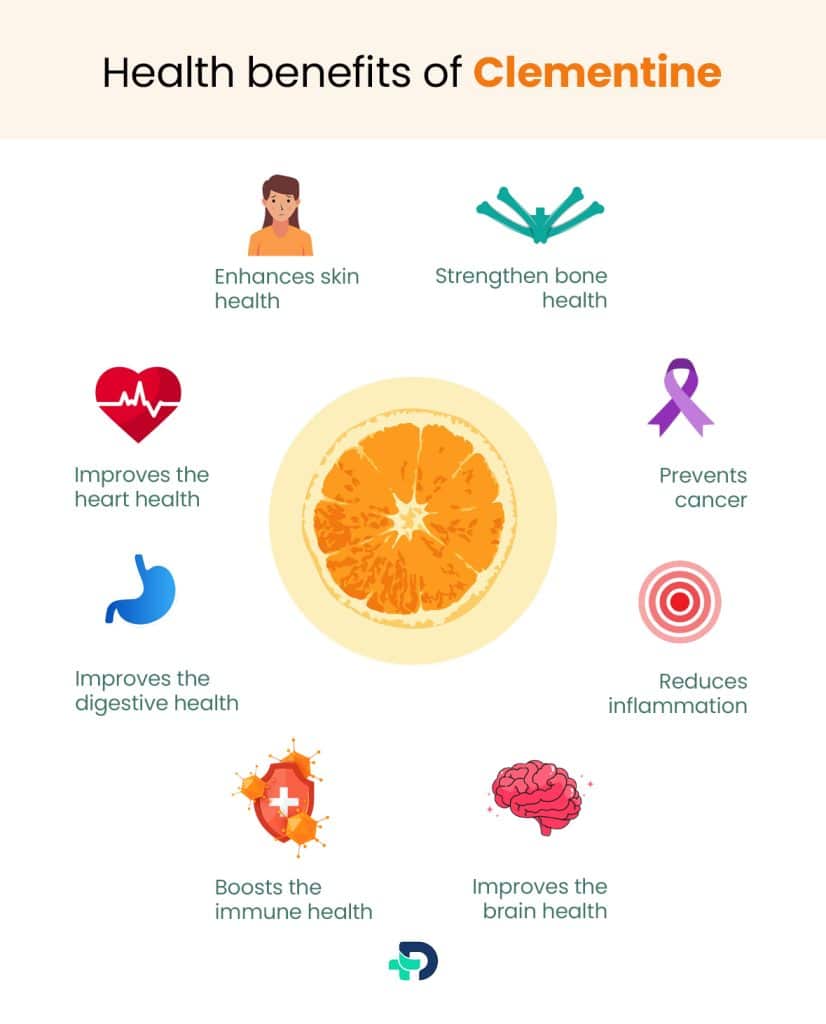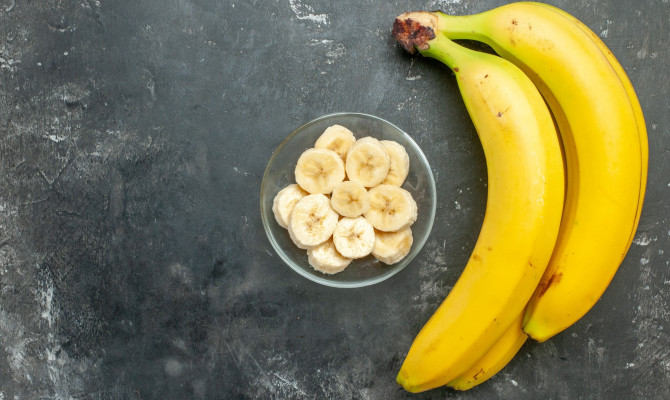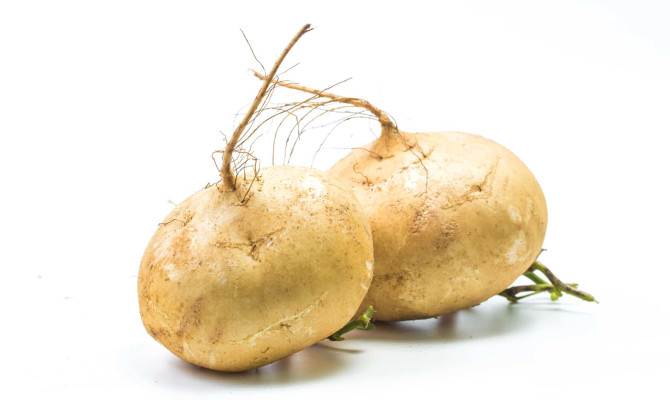Clementine : Nutrition and Health benefits

- Clementine
- 17 Aug 2023
Overview
What is Clementine?
Clementine is a citrus fruit hybrid of sweet oranges (Citrus sinensis) and mandarin (Citrus reticulata). Clementine are tiny juicy fruits from the Rutaceae family, the same family of grapefruits and raspberries.
It has a bright orange color, intense flavor and is sweeter and tastier than other citrus fruits. It has thin skin that one can easily separate.
Clementine may be seedless or with seeds depending on the variety. Some common types of Clementine are Fina, Algerian, Clemenules, and Clementine Caffin.

Facts of Clementine
- Clementine are a variety of mandarin oranges
- Clementine are commonly known as Cuties and Halos.
- It is native to Algeria, but now it is grown worldwide
- It is a winter crop and produces fruits between October and January
- China leads in the production of Clementine, followed by Turkey and Spain 1Overview| Researched based study from Sciencedirect.com
Nutrition
Nutrition in Clementine
Clementine is a small golf ball size fruit with high water content.
One raw Clementine (74 grams) consists of the following nutrients:
- Calories-35
- Carbohydrate-9gm (gram)
- Protein-1 gm
- Fat- 0 gm
- Fiber-1 gm
- Vitamin B9(Folate)- 5% of DV (% daily value)
- Vitamin B1 (Thiamine)-5% of DV
- Vitamin C-40% of DV 2Nutrition| Researched based study from Usda.gov
Most of Clementine’s calories come from the protein and the natural sugar present in it.
Other vitamins and minerals in Clementine
- Vitamin B6 (Pyridoxine)
- Vitamin E
- Iron
- Calcium
- Potassium
Fiber, vitamins, and minerals have the following function in our body:
Fiber
- It helps soak up water and accelerate the movement of stool in the intestine.
- It enhances gut health and prevents constipation
Vitamin B9 (Folate)
- It is required for the production of white and red blood cells
- It helps in natural tissue growth and cell execution
Vitamin B1 (Thiamine)
- B1 vitamin plays an indispensable role in the growth and functioning of cells
- It maintains the nervous system
Vitamin C
- It is essential for the development and restoration of the tissues
- It is vital for healthy skin and bones
Vitamin B6 (Pyridoxine)
- It is crucial for correct brain functioning
- It maintains the immune system and nervous systems
Vitamin E
- Vitamin E keeps the immune system healthy
- It decreases the oxidative stress in the body by neutralizing the free radicals.
Iron
- It helps in the growth and development
- Iron helps to make hemoglobin, a red blood cell protein necessary for the transport of oxygen from the lungs to tissues.
Calcium
- It is required for healthy bones and teeth
- It helps in regulating normal heart and nerve function
Potassium
- It is crucial for accurate nerve and muscle functioning
- It is vital for regulating the blood pressure in our body
Bioactive compounds in Clementine
Flavonoids
- Flavonoids are phenolic compounds found in plants
- It has anti-cancer and anti-inflammatory properties
Carotenoids
- Carotenoids are natural pigments present in the plants
- It has antioxidant properties and reduces the risk of chronic diseases
Beta –carotene
- Beta–carotene is a natural pigment present in vegetables and fruits
- In the body, beta carotene is transformed into vitamin A, promoting eye health and immune function and reducing the risk of infection 3Nutrition| Researched based study from Sciencedirect.com
Properties of Clementine
- Antioxidant
- Anticancer
- Anti-inflammatory
- Anti-depressant
- Anti-allergic
- Cardiovascular protection (protects heart and blood vessels)
Health Benefits

Health benefits of Clementine
The health benefits of Clementine are as follows:
- Enhances skin health
- Improves the digestive health
- Improves the heart health
- Boosts the immune health
- Strengthen bone health
- Prevents cancer
- Reduces inflammation
- Improves the brain health
Enhances skin health
- Nutrients in Clementine help in collagen production necessary for skin firmness and plumpness. Collagen is a protein necessary for healthy skin, bones, and muscles.
- It reduces the appearance of wrinkles 4Benefits| Researched based study from Nlm.nih.gov
Improves the digestive health
- Fibers in Clementine promote the growth of good bacteria in the gut
- It helps in regular bowel movements and prevents constipation 5Benefits| Researched based study from Nlm.nih.gov
Improves the heart health
- Nutrients in Clementine lower the total cholesterol in the body
- It decreases blood pressure and lowers the risk of heart diseases 6Benefits| Researched based study from Sciencedirect.com
Boosts the immune health
- Nutrients in Clementine reduce the risk of the common cold
- It also helps in early recovery from sickness 7Benefits| Researched based study from Nlm.nih.gov
Strengthen bone health
- Nutrients in Clementine maintain the bone mass
- It reduces the risk of osteoporosis 8Benefits| Researched based study from Sciencedirect.com
Prevents cancer
- Nutrients in Clementine reduce the abnormal cell growth
- It reduces the risk of breast, esophageal, and stomach cancer9Benefits| Researched based study from Nlm.nih.gov
Reduces inflammation
- Nutrients in Clementine decrease pain and swelling
- It helps in wound healing 10Benefits| Researched based study from Sciencedirect.com
Improves the brain health
- Nutrients in Clementine protect the brain from harmful substances
- It enhances the thinking ability 11Benefits| Researched based study from Sciencedirect.com
Side effects
Side effects of Clementine
Most people can tolerate Clementine well. However, some people might experience the following side effects:
- Itching
- Hives
- Skin rash
- Swelling in the mouth, tongue, lips, and throat
- Difficult breathing
Risk of Clementine
- Clementine contains the furanocoumarin compound present in grapefruits.
- Furanocoumarins are natural compounds found in Rutaceae family plants.
- Research shows that the furanocoumarin compound interacts with heart medications and more than 85 other drugs.
- So, people on medications must consult a health care professional regarding the probable interactions of the consumed drug and Clementine 12Side effects| Researched based study from Nlm.nih.gov
Contraindications
Who should avoid eating Clementine
- Those who are allergic to Rutaceae family fruits, including raspberry and grapefruits
- People with acid reflux disease
- One with the digestive disorder
- People on heart medication
- People on blood pressure medication
- If taking anti-depressant medication
- If receiving cancer medication 13Contraindications| Researched based study from Nlm.nih.gov
Selection
Buying & Selection of Clementine
- Clementine are best in winter, but one can buy Clementine all year round in supermarkets and stores sold as Cuties, Halos, and Darlings.
- Look for uniformly bright orange Clementine, shiny without any blemishes. The fruit must be soft, sweet-smelling, and when squeezed, must rebound back.
- Avoid Clementine that are too hard to touch and seem more lightweight than their size.
Tips
Tips to add Clementine in diet
- Enjoy ripe Clementine as a whole fruit snack at any time of the day
- Enjoy Clementine with almonds and cashews as an afternoon snack
- Add Clementine to savory and sweet dishes
- Substitute Clementine for oranges in fruit salads and spinach salads
- Top Clementine slices along with nuts and dry fruits to oatmeal and other breakfast cereals
- Blend skim milk, Clementine, and ice with fruits such as mango or pineapple and enjoy it as a smoothie
- Sauté Clementine with seafood such as shrimp and enjoy it as a side dish
- Dip Clementine in yogurt or chocolate and enjoy it
- One can make a Clementine cake and relish its taste
- Peel the skin, squeeze Clementine in a blender, and have it as fruit juice. However, it requires a lot to yield significant juice
- One can add Clementine to poultry marinates and relish its flavor and taste.
Preparation of Clementine
One can eat Clementine raw after peeling the skin. Clementine are very simple to peel.
Steps
- Take a ripe bright orange Clementine and wash it properly in running water.
- Peel the orange skin of Clementine from top to bottom and separate it into sections. Each section might contain few seeds or no seeds at all.
- Before eating yourself or giving it to a child, ensure to remove the seeds.
Storage
Storage of Clementine
- One can keep Clementine at room temperature for about a week
- Keep Clementine away from hot, humid places and direct sunlight
- It lasts for two to three weeks when kept in the refrigerator in the fruit drawer.
- Clementine is not associated with any food-borne diseases. Wash the fruit properly before consumption to avoid contamination from the peel.
Takeaway
Key Takeaways
- Clementine is a deliciously sweet citrus fruit with a rich source of vitamins and minerals.
- Clementine contains antioxidants that have many health benefits
- Clementine is a healthy and fun food for most people, including children, and one can eat it in a variety of ways
- However, people on medication must consult with a doctor before consuming Clementine
Any feedback on this article?
 This Articles content was accurate
This Articles content was accurate Very Informative Article
Very Informative Article I have a question or a comment
I have a question or a comment
 This article contains inaccurate content
This article contains inaccurate content This article was not helpful
This article was not helpful I have a question or a comment
I have a question or a comment
We appreciate your helpful feedback!
Checkout our social pages
References
-
Science Direct
Citrus Clementina - an overview | Overview
-
U.S. DEPARTMENT OF AGRICULTURE
Clementines, raw | Nutrition
-
Science Direct
Nutritional Composition of Clementine (Citrus x clementina) Cultivars | Nutrition
-
National Library of Medicine
The Roles of Vitamin C in Skin Health | Benefits
-
National Library of Medicine
Whole Fruits and Fruit Fiber Emerging Health Effects'. Nutrients | Benefits
-
Science Direct
Vitamin C and risk of coronary heart disease in women | Benefits
-
National Library of Medicine
Vitamin C and Immune Function | Benefits
-
Science Direct
Beta Cryptoxanthin - an overview | Benefits
-
National Library of Medicine
Citrus Fruit Intake and Breast Cancer Risk: A Quantitative Systematic Review | Benefits
-
Science Direct
Ascorbic Acid - an overview | Benefits
-
Science Direct
Hepatoprotective and cognitive-enhancing effects of hesperidin against thioacetamide-induced hepatic encephalopathy in rats | Benefits
-
National Library of Medicine
Clementine juice has the potential for drug interactions - In vitro comparison with grapefruit and mandarin juice | Side effects
-
National Library of Medicine
Grapefruit–medication interactions: Forbidden fruit or avoidable consequences? | Contraindications




































